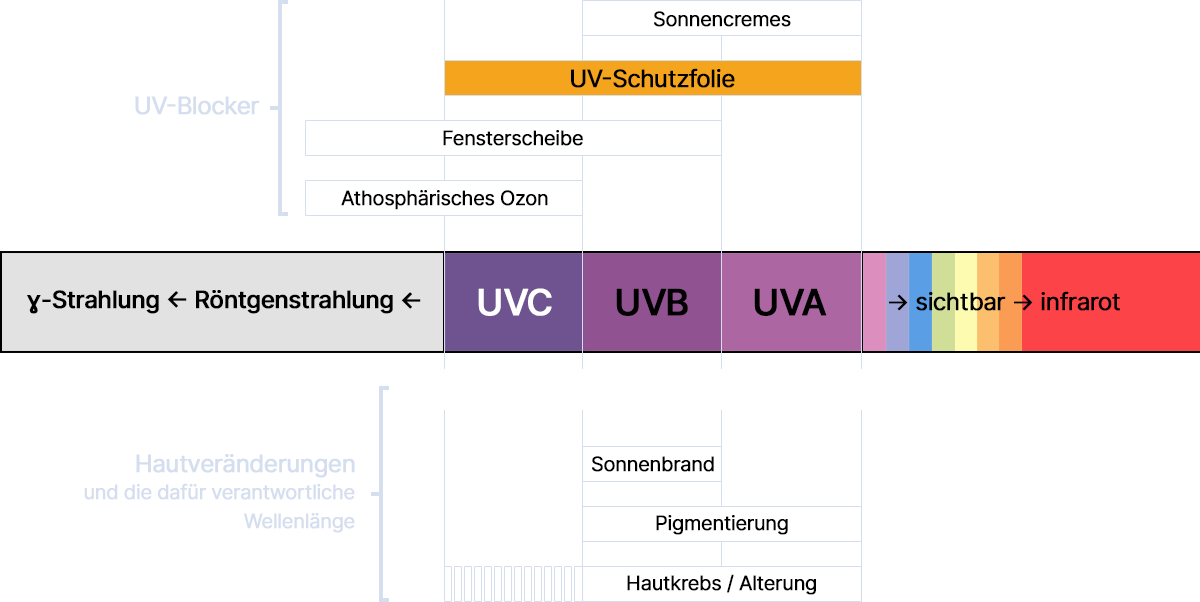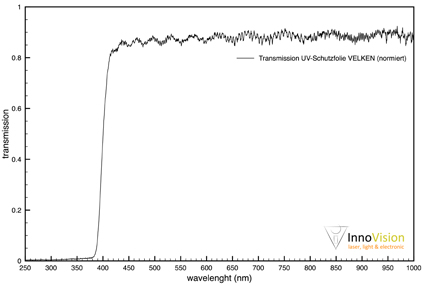
- Indoor assembly
- self-adhesive

- Indoor assembly
- self-adhesive

- Indoor assembly
- glueless
The radiation spectrum of the sun's rays
The sun's rays consist of light waves of different frequencies. The shorter the length of the light waves, the more energetic they are and the stronger the effects when the rays strike.
The following diagram shows the emission spectrum of the sun. The light spectrum visible to humans is in a wavelength of about 400 and 780 nm. To the left of this, the wave range of ultraviolet light (UV radiation for short), which is no longer visible to the human eye, begins at 400nm. This ends at 200 nm. The UV radiation of natural sunlight is largely responsible for the fading of objects as well as for possible skin changes when people are exposed to sunlight for too long without protection.
The most effective and energetic rays of the sun are the ultraviolet rays (UV rays) in a wavelength between 100 - 380 nanometres (nm).

The different types of UV radiation
Just like visible light is divided into different colours, UV radiation is divided into three ranges: UVA, UVB and UVC.
| Classification of UV light according to DIN 5031 | Wavelength |
|---|---|
| UV-A | 380 nm - 315 nm |
| UV-B | 315 nm - 280 nm |
| UV-C | 280 nm - 100 nm |
- UVC rays are the most energetic due to their short frequency. They are so intense that they would kill people if they were exposed to them for a longer period of time. Fortunately, these UV rays are completely swallowed up by the earth's atmosphere and do not reach the earth's surface.
- The UVB radiation is partially weakened by the ozone layer of the air envelope with its clouds and smog. They only have a 5% share of the total UV spectrum. The UVB rays are responsible for vitamin D formation in the body and ensure a brown hat. Too much of this radiation causes sunburn in humans.
- Similar to visible light, UVA radiation is largely transmitted by the air envelope. They penetrate deeper into the skin than UVB rays and lead to premature skin ageing when exposed to excessive amounts. There is also a risk of skin cancer.
Effective protection with UV protection film
Therefore, it is important to protect oneself from too long and too strong sun exposure. Outdoors, protection is achieved by regularly applying a sunscreen with a high sun protection factor. In buildings, sunlight usually enters through glass window surfaces. Window panes have a certain UV protection ex works, but this only protects in the UVB and UVC range.
Effective protection against all UV rays on glass surfaces can be easily retrofitted by applying a UV protection film. The UV protection films are crystal clear, self-adhesive and therefore visually inconspicuous. Cut to size, the window films can be installed in a short time and henceforth provide more UV protection for people and objects indoors.
UV protection film demonstrably blocks UV radiation

A UV protection film must mainly block the UVA and UVB rays that penetrate strongly to the earth for wavelengths below 380 nm, so that objects behind it are protected from fading.
The graph on the left shows the measurement results of our UV protection film for wavelengths between 250 and 1000 nm. The curve shows that UV rays up to 378.1 nm are blocked 100%. Only above that does the light transmission of the ultraviolet radiation increase. This results in 99.5% protection against UV radiation. Really good UV protection products are characterised by a shielding of more than 99%, conventional ones only just achieve this at best.
Theoretically, despite the protective film, rays with wavelengths > 378 nm can still affect objects behind the film. Unfortunately, 100% protection cannot be guaranteed. An effective UV protection film can slow down the fading of objects by a factor of 3-5.
UV protection films offer many advantages for protecting objects from the harmful effects of ultraviolet light.
Here are five benefits of UV protective films:
-
Extended life: UV protective films protect items from fading, yellowing and degradation, which can extend the life of products.
-
Improved protection: UV protection films are able to block up to 99% of UV light, providing better protection against UV damage.
-
Reduced costs: As UV protective films extend the life of items, they can save money in the long term by reducing the need for replacement and repairs.
-
Ease of application: UV protection films are easy to apply and can be applied to many different materials without much effort.
-
Beautification of appearance: UV protection films can also help objects and materials look attractive for longer as they protect against fading and yellowing. In addition, UV protection films come in different colours and designs, which offers the possibility to enhance the appearance and create a customised look.
FAQ's about UV protection films
What are the benefits of UV protection films?
UV protection films slow down the fading of objects exposed to sunlight near windows. UV radiation from the sun causes all surfaces to fade over time. With a UV protection film, this process is slowed down by a factor of 3-4.
In addition, UV protection films can effectively prevent bird strikes on windows because birds can see the reflected UV light and thus recognise the UV film as a grey wall.
How do I attach UV protection film?
There are self-adhesive UV protection films which stick firmly to the pane due to the film adhesive applied to the back. Once wet, they last a very long time and can only be removed once without leaving any residue.
How do I apply UV protection film?
Self-adhesive UV protection films have a transparent adhesive applied to the back, just like a sticker. On top of this is a protective film that must first be peeled off. Now the adhesive side and the pane are sprayed with water. Then the film is placed on the glass and the water is wiped out from under the film.
How do I remove UV protection film from the window?
To remove a UV protection film, grasp it at one corner and then slowly pull it off at a wrong angle. In the case of adhesive films, the film can be warmed by hand with a hair dryer beforehand to dissolve the film adhesive.







